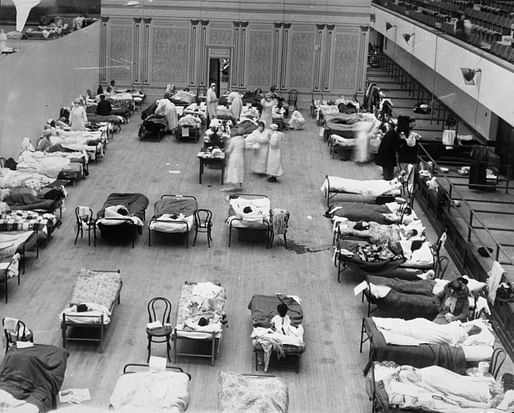

The American Institute of Architects (AIA) has announced the creation of a special task force that aims to educate public officials, healthcare facilities, and other architects on how to adapt existing buildings for temporary hospital use.
According to a statement published by the group this morning, the task force will encourage "federal, state and local government to adapt appropriate existing buildings to meet the growing healthcare and quarantine needs resulting from the COVID-19 pandemic," a phenomenon that has already begun to take shape in some of the cities hardest hit by the coronavirus pandemic, where the need for hospital beds is quickly outstripping the available supply.
The task force will focus on crafting a "COVID-19 Rapid Response Safety Space Assessment for AIA members that will include considerations for the suitability of buildings, spaces, and other sites for patient care. The assessment will be developed by architects with a wide range of expertise, including healthcare facility design, urban design, public health and disaster assistance," the statement reads.
“This is a race against time for healthcare facilities to meet bed surge capacity needs” writes AIA Academy of Architecture for Health President Kirsten Waltz in the statement, adding, "This task force will help inform best practices for quickly assessing building inventory and identifying locations that are most appropriate to be adapted for this crisis.”
“On a daily basis, I am hearing from our architects who feel a deep sense of moral duty to support our healthcare providers on the frontlines of this pandemic,” adds AIA 2020 President Jane Frederick, FAIA. “As our communities assess buildings to address growing surge capacity, we hope this task force will be a resource to ensure buildings are appropriately and safely adapted for our doctors and nurses.”
The creation of the task force comes as the architecture industry makes up for lost ground in the growing mobilization against the virus.
The Army Corps of Engineers recently produced a rapid retrofit plan for existing hotel and convention center spaces that largely skips over architects and gives over final design powers to contractors, for example. And in certain states, including California, construction has been deemed an essential service, but directives have so far said little on how (or if) architects can contribute proactively to these efforts. as rapid-response efforts have been led largely by the military and the Federal Emergency Management Agency.
At the same time, educators have taken matters into their own hands and a growing network of schools of architecture have shifted some of their capabilities toward the fabrication of protective medical gear.
Archinect reported yesterday that professors from Princeton University, Columbia University, Barnard College, and Cornell University, among others, had banded together to convert digital production labs into fabrication centers.
With the worsening situation and growing number of infections resulting from COVID-19, the architecture is experiencing an all-hands-on-deck moment that should receive additional urgency and focus from the AIA's latest initiative.
No Comments
Block this user
Are you sure you want to block this user and hide all related comments throughout the site?
Archinect
This is your first comment on Archinect. Your comment will be visible once approved.